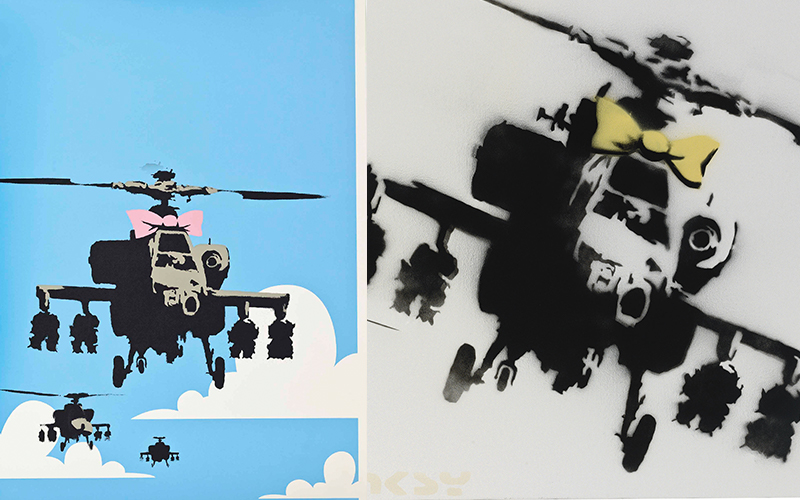

The picture was sold as an unsigned silkscreen by the artist collective POW (Pictures On Walls). War and invasion are depicted here in a trivialised way. On the one hand, through a pink bow on some versions of the helicopter and, on the other, through the childlike clouds in the background. Through his artistic skills, Banksy questions the glorification and romanticised representation of wars. He criticises the West’s way of reassuringly portraying its wars in the media as “precision bombing”, as if war were a surgical procedure without the hell of extreme violence, the killing of innocent children, the destruction of families, homes and survivors with permanent damage and injuries. This is the portrayal of war that many Western commentators copied from CNN during the first Gulf War. Since that time, the West has continued this PR ploy. When the picture was taken, the Apache helicopter was mainly used by US and British troops in Afghanistan.
Als unsignierter Siebdruck wurde das Bild vom Künstlerkollektiv POW (Pictures On Walls) verkauft. Krieg und Invasion werden hier verniedlicht dargestellt. Zum einen durch eine rosafarbene Schleife an manchen Versionen des Hubschraubers und zum anderen durch die kindlich gestalteten Wolken im Hintergrund. Durch seine künstlerischen Fertigkeiten hinterfragt Banksy die Verherrlichung und romantisierte Darstellung von Kriegen. Er kritisiert die Art und Weise des Westens, seine Kriege in den Medien beruhigend als „Präzisionsbombardierung“ darzustellen, als wäre Krieg ein chirurgischer Eingriff ohne die Hölle extremer Gewalt, die Tötung unschuldiger Kinder, die Zerstörung von Familien, Häusern und Überlebende mit bleibenden Schäden und Verletzungen. Diese Darstellung des Krieges schauten sich viele westliche Kommentatoren während des ersten Golfkriegs von CNN ab. Seit dieser Zeit fährt der Westen diese PR-Masche immer weiter. Als das Bild entstand, wurde der Apache-Hubschrauber vor allem von US-amerikanischen und britischen Truppen in Afghanistan eingesetzt.
En tant que sérigraphie non signée, l’œuvre a été vendue par le collectif d’artistes POW (Pictures On Walls). La guerre et l’invasion sont présentées ici d’une manière dédramatisée. On voit d’une part les nœuds roses apposés sur les hélicoptères et, d’autre part, les nuages au design enfantin de l’arrière-plan. Par son talent artistique, Banksy interpelle sur la glorification et la représentation romancée de la guerre. Il critique la manière dont l’Occident décrit ses guerres de manière réconfortante dans les médias comme des « bombardements de précision », comme si la guerre était une intervention chirurgicale sans violence, sans meurtre d’enfants innocents, sans destruction de familles, de maisons et sans survivant traumatisé ou blessé à vie. De nombreux commentateurs occidentaux ont copié cette image sur CNN pendant la première guerre du Golfe. Depuis, l’Occident utilise encore et toujours cette combine de relations publiques. Lorsque cette photo a été prise, l’hélicoptère Apache était surtout utilisé en Afghanistan par les troupes américaines et britanniques.
Obraz sprzedano jako niepodpisany sitodruk zbioru artystycznego „POW” („Pictures On Walls”). W strywializowany sposób przedstawiono tu wojnę i inwazję. Z jednej strony poprzez różową kokardkę, na niektórych wersjach helikoptera, a z drugiej poprzez dziecięce chmurki w tle. Wykorzystując swoje umiejętności artystyczne, Banksy kwestionuje gloryfikację i romantyczne przedstawianie wojen. Krytykuje sposób, w jaki Zachód uspokajająco przedstawia swoje wojny w mediach jako „precyzyjne bombardowania”, tak jakby wojna była zabiegiem chirurgicznym bez piekła, ekstremalnej przemocy, zabijania niewinnych dzieci, niszczenia rodzin, domów i ocalałych z trwałymi uszkodzeniami i obrażeniami. Jest to obraz wojny, który wielu zachodnich komentatorów czerpało z CNN podczas pierwszej wojny w Zatoce Perskiej. Od tego czasu Zachód wciąż stosuje tę PR-ową sztuczkę. W czasie, gdy wykonano to zdjęcie, śmigłowiec Apache był używany głównie przez wojska amerykańskie i brytyjskie w Afganistanie.
Værket blev solgt som et usigneret serigrafi af kunstnerkollektivet POW (Pictures On Walls). Her fremstilles krig og invasion på en banalt vis – blandt andet gennem en lyserød sløjfe på helikopteren og de barnlige skyer i baggrunden. Med sin velkendte billedkraft stiller Banksy spørgsmålstegn ved glorificeringen og den romantiserede fremstilling af krig. Han kritiserer Vestens måde at fremstille egne militære operationer som “præcisionsbombning” – som var krig et kirurgisk indgreb uden vold, død, ødelæggelse og livsvarige traumer. Det er denne version af krig, mange vestlige medier adopterede fra CNN under den første Golfkrig – og som Vesten har holdt fast i siden. På det tidspunkt værket blev skabt, blev Apache-helikoptere hovedsageligt brugt af amerikanske og britiske tropper i Afghanistan.
Attēls tika pārdots kā neparakstīts sietspiedes darbs, ko radīja mākslinieku kolektīvs “POW” (“Pictures On Walls”). Kara un iebrukuma tēma šeit ir attēlota banāli. Dažās versijās ar rozā lenti uz helikoptera, bet citās versijās – ar bērnišķīgiem mākoņiem fonā. Ar savām mākslinieciskajām prasmēm Banksy apšauba kara glorifikāciju un tā idealizēto attēlojumu. Viņš kritizē Rietumu valstis par to, ka tās plašsaziņas līdzekļos savus karus attēlo kā “precizitātes bombardēšanu”, it kā karš būtu ķirurģiska procedūra bez ekstremālas vardarbības, nevainīgu bērnu nogalināšanas, ģimeņu, māju un izdzīvojušo iznīcināšanas, kā arī neatgriezenisku traumu un ievainojumu radīšanas. Šis ir kara attēlojums, ko daudzi Rietumu valstu komentētāji pārņēma no “CNN” pirmā Persijas līča kara laikā. Kopš tā laika Rietumi turpina šo publicitātes paņēmienu. Kad tika uzņemta šī fotogrāfija, “Apache” helikopterus galvenokārt izmantoja ASV un Lielbritānijas karaspēks Afganistānā.